[Editor’s note] The candidates with the highest score in Jiangsu liberal arts are not allowed to go to Qingbei Nanda because their history subject level is B+. Many people said that they could not understand the current college entrance examination. In fact, in Jiangsu’s current "3+2" recruitment model, Tsinghua of Peking University has been asking for double A or above for many years. But this will be the last year for Jiangsu to use the old model. Jiangsu will implement the new college entrance examination plan next year. 澎湃 Mathematics course took Zhejiang, the first batch of reforms, as an example last year, sorting out the long examination course and 35 subject choices of the new college entrance examination. In a blink of an eye, Zhejiang sent out four new college entrance examination students. With minor adjustments and small patches, local reforms were rolled out one after another, and the reform ideas disassembled in this paper were basically continued.
In our second and third year of high school, we may have experienced many exams and model exams, but the college entrance examination is only in June of the third year of high school, so it is also called "one exam will set you for life". However, in today’s high schools in Zhejiang, students of Grade Two begin to prepare for the academic proficiency test early, which may become the first record that affects college admission.
The second year of high school started the college entrance examination, and it took two years to pass the "test"
Du Yiming, 19, is a senior three student in a first-class key middle school in Zhejiang Province. In addition to the number of words, Du Yiming chose physics, chemistry and biology as college entrance examination subjects. His college entrance examination began in November of the last semester of Senior Two.There are more key exams, and "every time matters, you can’t relax every time".
Du Yiming took part in the "first college entrance examination" of four subjects: biochemistry and foreign languages in November last year. On the first weekend of April this year, he will take part in the "second college entrance examination" for selected subjects. The results of the materialized students in these two exams will be included in the total score of the college entrance examination according to the grade assignment. By the time of the national college entrance examination in June, Du Yiming will face an exam beyond the number of languages. There is only one chance to get Chinese and math scores, and the foreign language scores will be included in the total score according to the actual test scores, based on the foreign language test results in November last year.
When the national candidates finished the college entrance examination in early June, Du Yiming was greeted by the "Trinity" exam of Zhejiang University. For Zhejiang candidates, if they want to sprint to some top universities in China, such as Peking University and Tsinghua, it is best to take the "Trinity" exam which is put forward by these universities in mid-June. In the end, the results of this exam will be combined with the scores of six subjects in the college entrance examination and the scores of earlier academic level exams to form the admission transcripts in proportion. Such a "trinity" admission quota may account for more than 80% of the admission channels of these colleges and universities; If candidates intend to enter the above-mentioned colleges and universities solely by the results of the college entrance examination, it is not impossible, but it also means giving up many opportunities automatically.
Du Yiming’s tense preparation schedule is not an isolated case. Compared with the traditional college entrance examination mode of "one exam determines life", the new college entrance examination reform in Zhejiang has undergone tremendous changes.
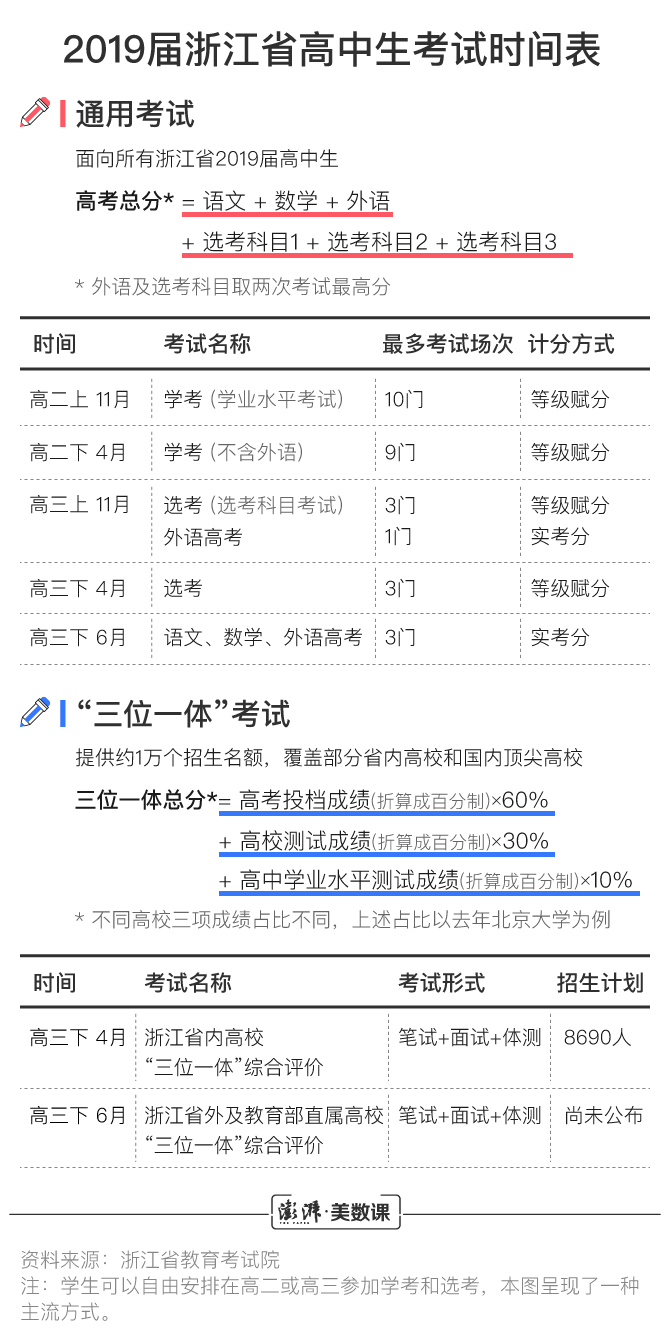
To sum up, there are probably three new features:
1. Cancel the division of arts and sciences, and use the new rule of "three subjects must be tested except the number of languages, and the other subjects should be selected from 7";
2. Foreign languages and elective subjects are provided with 2 examination opportunities, and the highest score is included in the total score of the college entrance examination, and the elective subjects are graded according to the ranking;
3. Not limited to the unified entrance examination, the "Trinity" enrollment scale of universities directly under the Ministry of Education in and outside the province has expanded.
The road to the new college entrance examination is full of choices besides hard work.
Option 1: Customize your own exam schedule.
Every candidate has a dense examination schedule in his hand. Different from the traditional "one exam for life" model, each exam in the above table may affect the final admission.
Do you want to participate in the "Trinity" enrollment? How many times do you need to take the exam? How many courses do you take each time? For these questions, candidates need to customize their own examination schedule according to their own situations and goals.
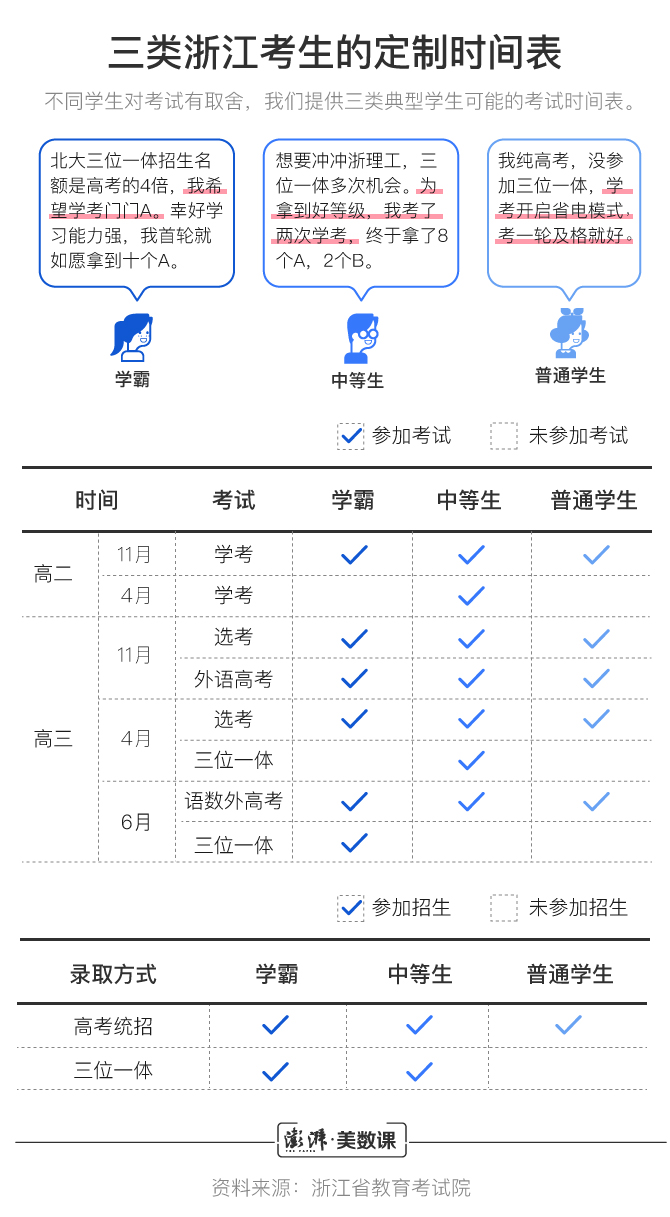
If we take the recruitment path of the general college entrance examination, it will affect the admission of two rounds of elective examinations and the college entrance examination of three subjects other than languages. As for the academic examination, as long as we "pass the exam", it will do.
If you take the "trinity" recruitment path, all the above exams will affect the admission: you need to get as many As possible A’s (accounting into the "trinity" total score) in the academic exam, take two rounds of elective exams and the college entrance examination outside the language number, as well as the "trinity" in-school test of your favorite university.
At present, there are 57 colleges and universities participating in the "Trinity" enrollment in Zhejiang, including 49 colleges and universities in the province and 8 colleges and universities directly under the Ministry of Education. Tsinghua University, Peking University, Shanghai Jiaotong University, Fudan University, Zhejiang University and China University of Science and Technology all participate in the "Trinity" enrollment.
According to the information released by Zhejiang Education Examinations Institute, there are 8,690 "Trinity" enrollment plans for colleges and universities in Zhejiang Province this year, and the "Trinity" enrollment brochures for colleges and universities outside the province and directly under the Ministry of Education have not yet been released, with 1,664 students last year. Since the enrollment plan for the general college entrance examination in 2019 has not been announced, if we refer to the 231,000 college entrance examination enrollment in 2018, the ratio of the two enrollment numbers is about 1:23, and the proportion of the "Trinity" in all enrollment can not be underestimated; It is even more important to occupy more than 80% of the enrollment in some colleges and universities.
Option 2: 35 combinations of courses, which three subjects to take?
After the reform of Zhejiang College Entrance Examination, seven subjects were arranged and combined, and 35 different ways of selecting subjects were derived.
The Paper (www.thepaper.cn) found a general administrative class of "Chemistry+Biology" graduated from a first-class key middle school in Zhejiang Province in June 2018, and recorded the decision of 57 students in this class to choose subjects.
By comparing the ranking of each student in six large-scale exams in high school for three years, we find that it is very reasonable.Students should first consider the dominant subjects when choosing subjects.. Hao Chenfei, a teacher of the school, said: "Even if there is more room for some subjects in the future, students still choose subjects with their own advantages."
In this class, we found that eight students chose three subjects with the best grades in Grade One.
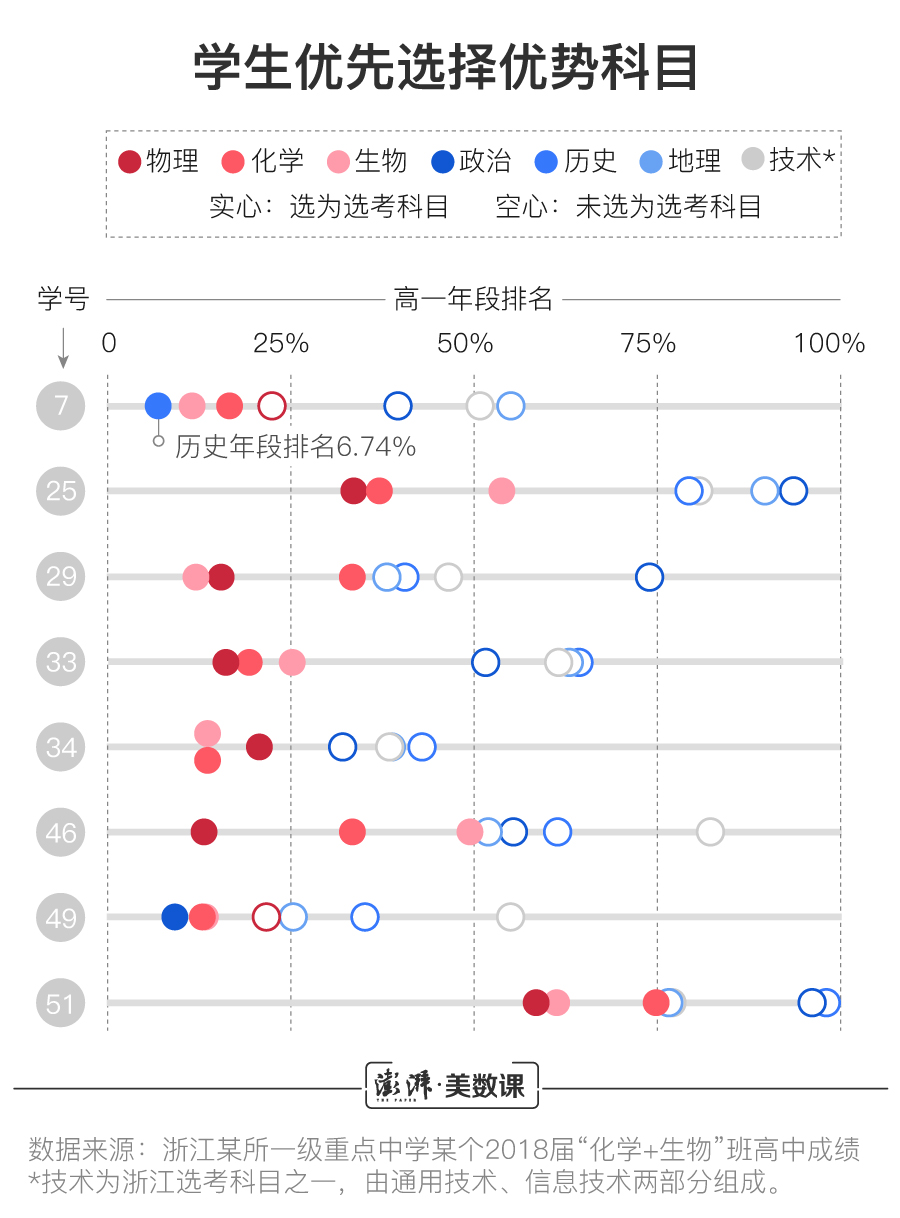
Such new rules may help some candidates to "overtake in corners".
We find out two all-round academic tyrants and two partial scientific tyrants in our class for comparison. The results of all-round academic tyrants in every subject in Grade One of Senior High School are in the top 20% of the year, and the total scores of seven subjects rank the highest. The scores of the subjects selected by the partial science tyrants are all in the first 20% of the year, but the other subjects are relatively backward.
Let’s look back at the distribution of the scores of the all-round academic tyrants and the partial scientific tyrants in the first year of high school. The scores of these four students in the selected subjects are relatively close, but judging from the total scores of seven subjects, the all-round academic tyrants are completely ahead of the partial scientific tyrants:
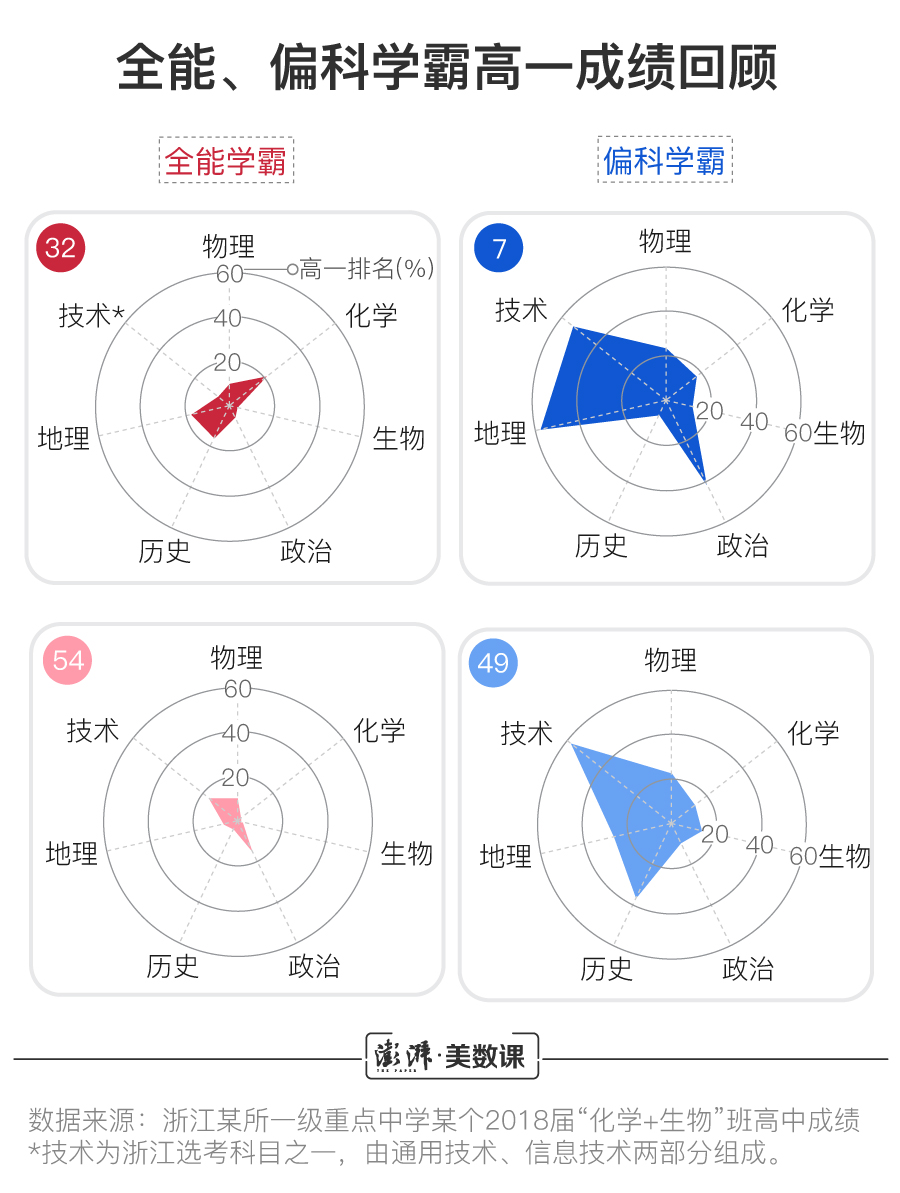
By choosing subjects, the partial science master got rid of the inferior subjects, narrowed the distance with the all-round learning master, and even surpassed the all-round learning master in the final ranking. According to the grading method, we convert the ranking percentage of the above four students in the six large-scale exams from Grade One to Grade Three into grading, and illustrate the performance curves of these students. If you only look at the two exams in senior three, you can’t even judge who is the all-round academic tyrant and who is the partial scientific tyrant.
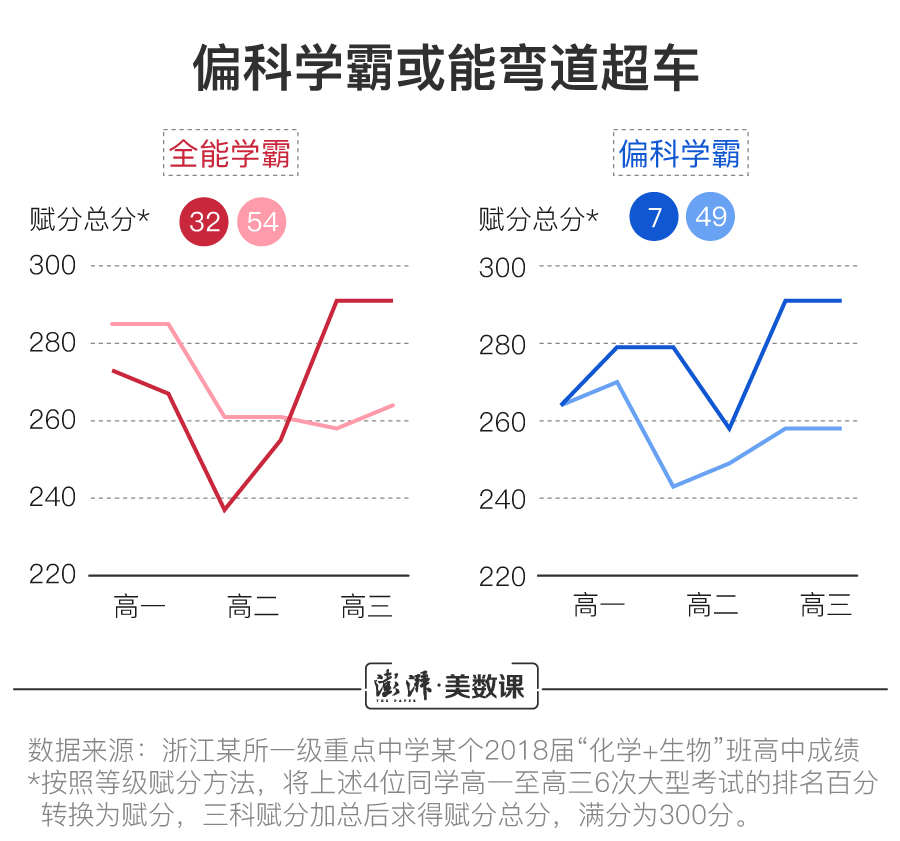
In this class, there are also students who do not choose the dominant subjects completely according to their personal rankings.
The reason for this phenomenon may be that candidates consider choosing a major in the future. Li Zirui, a senior three student in this school, became interested in computer programming in his freshman year. In order to further his studies in computer science in the future, he "chose physics almost without hesitation when choosing a subject".
Option 3: How to foster strengths and avoid weaknesses under the customized rules of colleges and universities?
The new college entrance examination rules also provide colleges and universities withMore recruitment autonomy.
On the one hand, unlike in the past when there were only two types of students in arts and sciences, there are more targeted requirements for students to choose examination subjects when enrolling students in various majors in colleges and universities. For example, Peking University’s astronomy and psychology majors require candidates to choose subjects that contain physics; The majors of finance and finance in Renmin University of China require candidates to choose subjects containing history or physics; Zhejiang University’s humanities experimental class is not limited to elective subjects.
According to Zhejiang Education Examinations Institute, in 2019, 6.8% of the subjects required for the examination were one, 8.8% were two, 23.3% were three and 61.1% were unlimited. Compared with 2017, in 2019, some colleges and universities put forward more explicit requirements for the selected subjects for majors with clear training requirements and high correlation with the subjects studied in middle schools, while those with broader basic literacy requirements appropriately relaxed the scope of the selected subjects.
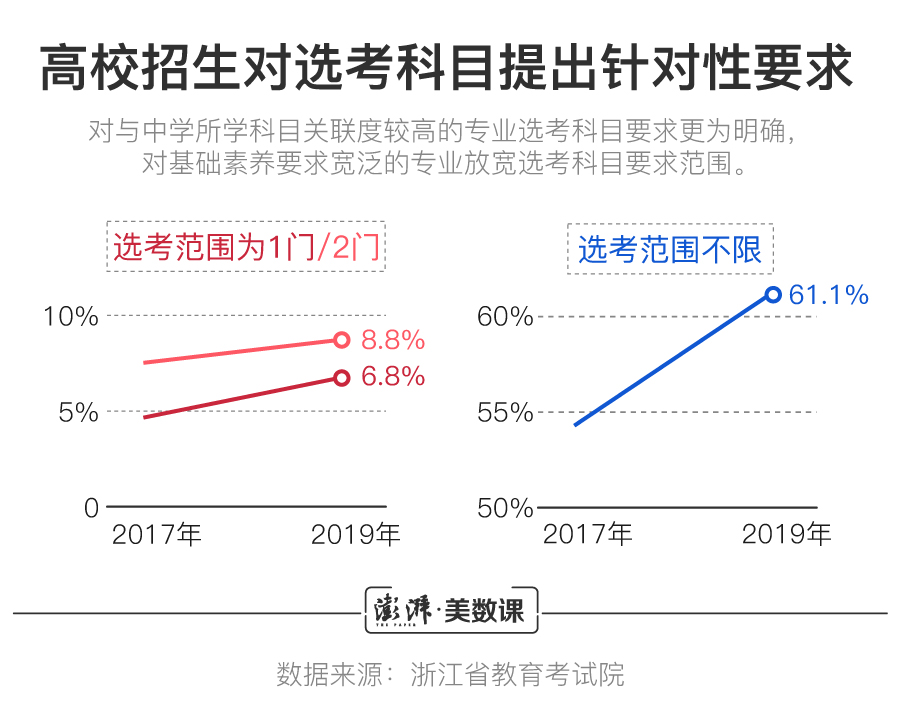
On the other hand, the "Trinity" comprehensive evaluation enrollment channel has been widened. Colleges and universities can organize on-campus tests more independently, screen students and select the best candidates through written tests, interviews and physical tests.
Take eight universities outside Zhejiang Province and universities directly under the Ministry of Education in 2018 as an example. The total number of students enrolled by these top universities in Zhejiang through the college entrance examination is 1,696 (including 1,618 from Zhejiang University), while the number of students enrolled through the "Trinity" is 1,664, which is close to 1:1 in overall scale.
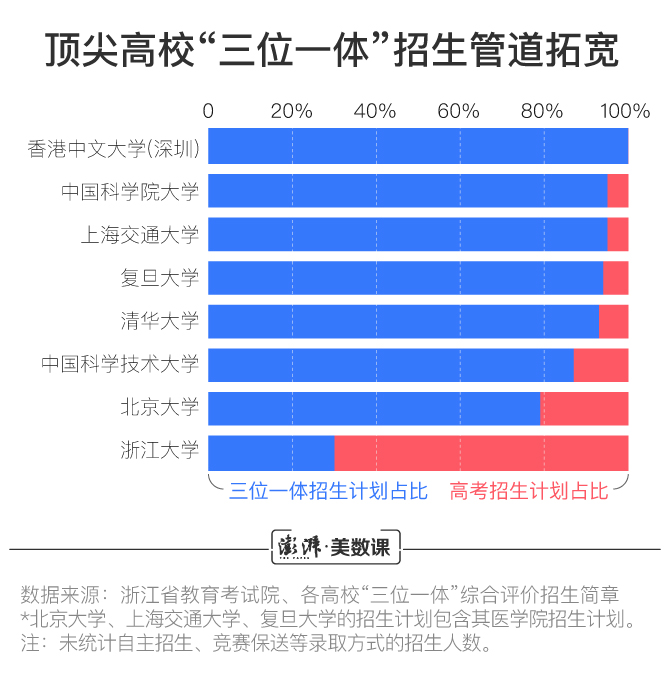
If Zhejiang University is stripped off, the number of people recruited by other top universities in China through the "trinity" comprehensive evaluation has far exceeded the enrollment of the college entrance examination. In other words, if you are a fresh graduate and want to be admitted to the above seven top universities, the safest plan is to participate in the "trinity" comprehensive evaluation enrollment of these schools; Otherwise, when the college entrance examination is filed, even if there is a very good college entrance examination result, the enrollment places of these top college entrance examinations are few and far between. Take last year’s enrollment plan as an example.Tsinghua University enrolled 8 students in Zhejiang through the college entrance examination and 105 students in Zhejiang through the Trinity. Peking University enrolled 23 students in Zhejiang through the college entrance examination and 85 students in Zhejiang through the Trinity.
In addition to broadening the enrollment channels, colleges and universities also have greater initiative in the on-campus testing stage, and can screen candidates in multiple dimensions such as written test, interview and physical fitness test.
Taking the written test as an example, in the "Trinity" comprehensive evaluation test of top universities in China, physics, as a "sharp weapon" for screening candidates, has become a compulsory subject for most candidates. Even if the candidate’s college entrance examination subject is not physics, he may be examined in the written test on campus. According to Tsinghua University’s "Trinity" Comprehensive Evaluation Admissions Guide for Zhejiang Province in 2018, in the on-campus test, 77.1% of the candidates were examined in physics during the written test.
Peking University’s "Trinity" comprehensive evaluation is similar. Regarding the written test content of college tests, Peking University’s 2018 Zhejiang "Trinity" comprehensive evaluation enrollment brochure stipulates that there are five written test subjects, of which three subjects are required to be tested, and two are selected from the four subjects of "physics, history, chemistry and politics", requiring "physics".
In 2014, Du Yubo, then Vice Minister of Education, used four "most" words to describe the reform of the new college entrance examination: "This examination enrollment system reform is the most comprehensive and systematic reform since the resumption of the college entrance examination, and it is the most important and complicated reform in the comprehensive education reform".
In a blink of an eye, Zhejiang New College Entrance Examination has sent out two students. In 2019, senior high school students are about to sprint the college entrance examination in June and become the third graduates of the new college entrance examination. In the process of implementation, minor adjustments are still taking place in Zhejiang.
No matter the front-line teachers and students or the education reform experts, there is no agreement on how to deal with this zero-sum game. In a broader sense, it remains to be seen where the college entrance examination reform in China will go.
At the request of the interviewee, the teachers and students in this article are all pseudonyms.
关于作者